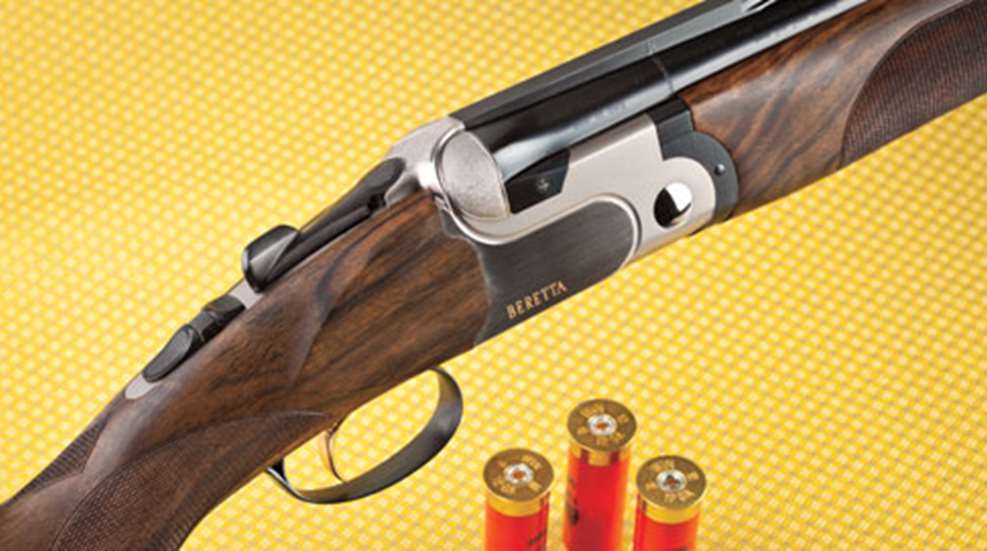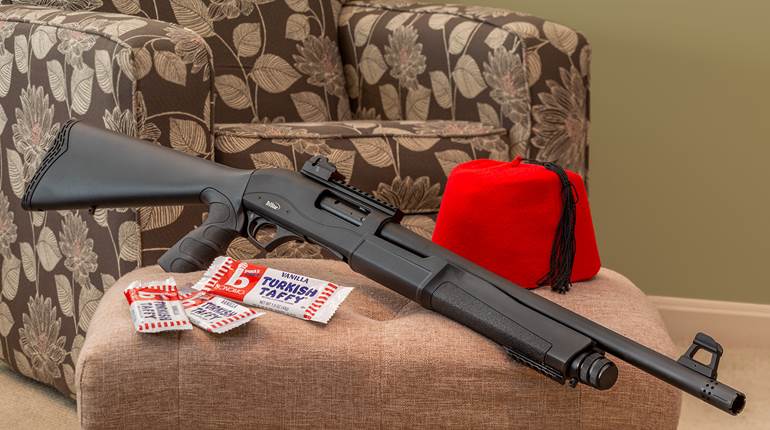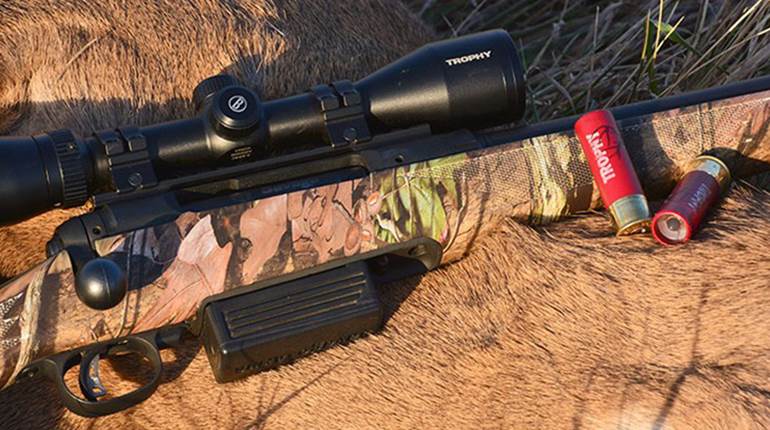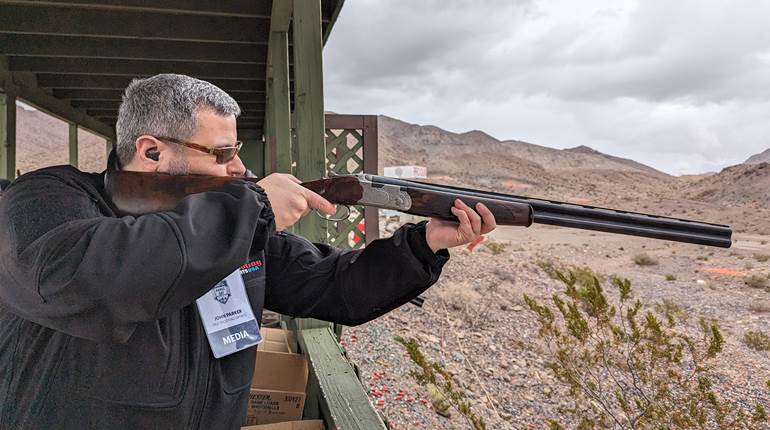
Designed for breaking clay targets, the Beretta DT10 is actually an extension of the company’s ASE 90. Made from 1992 through 1999, the ASE 90 was Beretta’s attempt to build a hand-made shotgun at a price that fit between its top-of-the-line SO series and the range of over-unders in the 686 series. Although made in trap, skeet and sporting configurations, Beretta did not produce many ASE 90s, probably because they required so much bench time. As a result of manufacturing evolution, Beretta is able to produce the DT10 using a combination of hand work and modern high-tech machining, bringing it into the under-$10,000 range.
Clay-target guns must stand up to exponentially more shooting, opening and closing than any hunting gun, hence the heavy-duty construction of the DT10. Like Beretta’s 686 series of over-under shotguns that use trunnions to hinge the barrels, and lockup by two lugs projecting from the breech face, the DT10’s barrels also hinge on trunnions or “stubbs,” as the British call them, but the lockup is by means of a hefty Greener-style crossbolt.
The action is large and machined from steel finished in satin-silver with the Beretta name set in gold. The replaceable trunnions make tightening the action easy should that become necessary. Our test gun was initially very stiff, but worked in after about 2,000 shells. Normally associated with German-made shotguns, the Greener-style crossbolt projects from the left side of the action, and it mates with two large lugs that project from the barrels about one-third of the way down the top chamber’s face. This style of lockup provides a slim action profile, where the barrels reside low in the frame.
The advantage of a low-profile action is that it locates the barrels more in line with the buttstock, directing the recoil straight back where it is taken up by the large muscles of the torso and not against the cheek and face.
Unique to the DT10 is the easily removable trigger group, which is equally strong as the action. Two massive V-springs power the hammers. Although more prone to break than coil springs, V-springs provide faster lock times and better trigger pulls. When measured, the trigger pulls registered an extremely light and very consistent 3.5 pounds. Beretta includes an extra-wide substitute trigger should the user want that kind of feel.
The top lever is fairly short and terminates in a unique rectangular spatula, and the manual safety catch carries the familiar lateral sliding Italian-style barrel selector.
Barrels are the heart of a shotgun’s downrange performance. These are of top quality, and the test DT10’s bores are a very consistent 0.730 inches from the end of the long forcing cone to the base of the screw-in choke shoulder. Measured with a digital bore micrometer, it is hard to recall a more consistent pair of barrels. The polishing is excellent and the bluing is a dark, deep blue. The ejectors are heavier than on most over-unders, which is an indicator of the gun’s potential reliability throughout thousands of rounds. The rib on the Sporter tapers from 10 mm to 7 mm, and is machine-checkered to a glare-free finish. The DT10 comes with an installed white front bead and a small steel mid-rib bead. Included in the spare-parts kit are both small and large florescent-red replacement beads for those who prefer them. Chambered for 3-inch shells, it is doubtful any dedicated clay-target shooter would use this gun for waterfowling, but he certainly could. The barrels are of tough steel, and should not be affected by steel shot; there are some sporting clays ranges that, because of their proximity to water or wetlands, require lead-free shotshells.
Measuring approximately 4 inches, the forcing cones provide a long, gentle passage of the shot charge from the chamber to the bore. The muzzles are threaded for Beretta Optima-Bore chokes. The DT10 comes with five choke tubes marked skeet through improved modified.
The stock is of nicely figured dense European walnut. The oil finish was a bit dry looking, but that’s typical of many shotguns finished with traditional oil. It is fairly straight with drop at comb measuring 17⁄16 inches and at the heel 2¼ inches respectively, and is cast off for a right-handed shooter. The buttstock is hefty and thick, reflecting the heavy build of the rest of the DT10, and broadening out at the butt to spread recoil over a wider area of the shooter’s shoulder. The tight pistol grip features a slight palm swell. The fore-end is fairly slim, yet hand filling. It terminates in a Schnabel that reinforces the thin wood against splitting. The checkering on both butt and fore-end is about 18 to 20 lines per inch.
Our initial reaction to the DT10 Sporter is that for an 8-pound, 6-ounce shotgun, it seemed amazingly light between the hands and well balanced. Shooting it was a pleasure. Recoil was mild with handling that sets it apart from other clay guns. Patterning proved to be very good with Briley choke tubes calibrated to the barrels. The bottom barrel shooting a 0.015-inch, light-modified tube that is favored by many competitors the patterns averaged 54 percent at 40 yards, and the top barrel with a 0.020-inch modified tube averaged 61 percent with 11⁄8-ounce No. 8 Federal Top Gun target loads.
Though not inexpensive, the Beretta is well below the price of other clay-target specific shotguns and represents good value for the money. By all appearances it should last several generations of hard shooting with only minor tweaking needed to bring it back to mechanical perfection.
Manufacturer: Pietro Beretta, Gardone, Italy,
Importer: Beretta USA; (301) 283-2191; www.berettausa.com
Action type: boxlock over-under shotgun
Gauge: 12, 3"
Trigger: single selective; adjustable to accommodate hand size
Barrel: 28"-, 30"- and 32"-lengths, Beretta Optima-Bore with 3" chambers and Beretta Optima chokes
Sights: tapered ventilated rib (from 10 to 7 mm) white front bead with steel mid-rib bead. Red fluorescent replacement front beads included.
Stock: select European walnut; length of pull: 14¾"; drop at comb: 17⁄16"; drop at heel: 2¼"
Overall Length: 48¼" with Optima-Choke installed
Weight: 8 lbs., 6 ozs.
Metal Finish: action, satin-silver-finished steel, barrels blued
Accessories: two each extra strikers and springs, extra-wide replacement trigger, small and large fluorescent red beads, screwdriver (for trigger work), choke tubes
Suggested Retail Price: $7,650





































